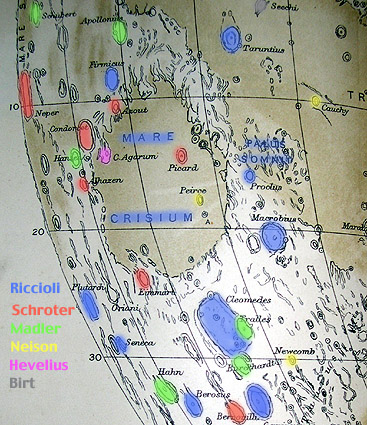Difference between revisions of "May 11, 2004"
| Line 1: | Line 1: | ||
__NOTOC__ | __NOTOC__ | ||
=Who Named That Crater?= | =Who Named That Crater?= | ||
| − | + | <p align="center"> | |
| − | + | <table width="640" border="0" align="center" cellpadding="6" cellspacing="2"> | |
| − | + | <tr> | |
| − | + | </tr></table> | |
| − | |||
| − | |||
| − | |||
<table border="0" align="center" cellpadding="6" cellspacing="2"> | <table border="0" align="center" cellpadding="6" cellspacing="2"> | ||
| − | + | <tr> | |
| − | + | <td><div align="center">[[File:LPOD-2004-05-11.jpeg|LPOD-2004-05-11.jpeg]]</div></td> | |
| − | + | </tr> | |
| − | + | <tr> | |
| − | + | <td colspan="2"><div align="center"> | |
| − | + | <p class="main_sm">Image Credit: [mailto:tychocrater@yahoo.com C.A. Wood] on Elger's Map</p> | |
| − | + | </div></td> | |
| − | + | </tr> | |
| − | + | <table class="story" border="0" bgcolor="#FFFFFF" width="90%" cellpadding="10" align="center"> | |
| − | + | <tr> | |
| − | + | <td><p class="Story" align="center"><b><span class="class">Who Named That Crater?</span></b></p> | |
| − | + | <p class="story" align="left">Lunar nomenclature, which is in some ways the least important aspect of the Moon, has a fascinating history. It doesn't really matter what a feature is named as long as everyone uses the same name for it. But names of historically interesting people are more interesting than other possible designations - I'd rather talk about Copernicus than 23136B which is that wonderful crater's catalog number in The System of Lunar Craters! In this map I have color-coded the sources for names on one small piece of the Moon. Most of the large and conspicuous craters were named by the earliest Moon mapper whose names took hold. Thus the blue craters have names given by Riccioli in 1651. Only one name from the earlier Moon mapper Hevelius (1647, pink) remains - Cape Agarum. Schroter (1791 and 1802) named features that are smaller or nearer the limb (red), and in 1834 Madler completed naming most of the well-defined craters (green). Mopping up of smaller craters continued by Neison (1876; yellow) and Birt (1880s, grey). Since this base map was published by Elger in 1895, additional names were given by Franz, Lamech, Arthur, Whitaker and NASA. And one named crater on this map has been deleted because it doesn't really exist - can you find it?</p> | |
| − | + | <p class="story" align="left"><b>Technical Details</b>:<br> | |
| − | + | The background map is part of the First Quadrant from Elger's The Moon (1895). I found the source for each name in Ewen Whitaker's Mapping and Naming the Moon (1999). </p> | |
| − | + | <p class="story"><b>Related Links:</b><br> | |
| − | + | [http://planetarynames.wr.usgs.gov/moon/moonTOC.html International Astronomical Union Nomenclature List<br> | |
| − | + | ][http://publish.uwo.ca/~pjstooke/hevelius.htm Hevelius' Nomenclature]</p> | |
| − | + | <p class="story"><b>Tomorrow's LPOD:</b> A Basin Near Schiller</p> | |
| − | + | </tr> | |
| − | + | </table> | |
| − | + | <hr> | |
| − | + | <p align="center" class="main_titles"><b>Author & Editor:</b><br> | |
| − | + | [mailto:tychocrater@yahoo.com Charles A. Wood]</p> | |
| − | + | <p align="center" class="main_titles"><b>Technical Consultant:</b><br> | |
| − | + | [mailto:anthony@perseus.gr Anthony Ayiomamitis]</p> | |
| − | + | <p align="center" class="main_titles"><b>A service of:</b><br> | |
| − | + | [http://www.observingthesky.org/ ObservingTheSky.Org]</p> | |
| − | + | <p align="center" class="main_titles"><b>Visit these other PODs:</b> <br> | |
| − | + | [http://antwrp.gsfc.nasa.gov/apod/astropix.html Astronomy] | [http://www.msss.com/ Mars] | [http://epod.usra.edu/ Earth]</p> | |
| − | |||
| − | |||
| − | |||
| − | |||
<p> </p> | <p> </p> | ||
| − | |||
| − | |||
---- | ---- | ||
===COMMENTS?=== | ===COMMENTS?=== | ||
Click on this icon [[image:PostIcon.jpg]] at the upper right to post a comment. | Click on this icon [[image:PostIcon.jpg]] at the upper right to post a comment. | ||
Revision as of 18:20, 4 January 2015
Who Named That Crater?
Image Credit: C.A. Wood on Elger's Map |
|
Who Named That Crater? Lunar nomenclature, which is in some ways the least important aspect of the Moon, has a fascinating history. It doesn't really matter what a feature is named as long as everyone uses the same name for it. But names of historically interesting people are more interesting than other possible designations - I'd rather talk about Copernicus than 23136B which is that wonderful crater's catalog number in The System of Lunar Craters! In this map I have color-coded the sources for names on one small piece of the Moon. Most of the large and conspicuous craters were named by the earliest Moon mapper whose names took hold. Thus the blue craters have names given by Riccioli in 1651. Only one name from the earlier Moon mapper Hevelius (1647, pink) remains - Cape Agarum. Schroter (1791 and 1802) named features that are smaller or nearer the limb (red), and in 1834 Madler completed naming most of the well-defined craters (green). Mopping up of smaller craters continued by Neison (1876; yellow) and Birt (1880s, grey). Since this base map was published by Elger in 1895, additional names were given by Franz, Lamech, Arthur, Whitaker and NASA. And one named crater on this map has been deleted because it doesn't really exist - can you find it? Technical Details: Related Links: Tomorrow's LPOD: A Basin Near Schiller |
Author & Editor:
Charles A. Wood
Technical Consultant:
Anthony Ayiomamitis
A service of:
ObservingTheSky.Org
Visit these other PODs:
Astronomy | Mars | Earth
COMMENTS?
Click on this icon File:PostIcon.jpg at the upper right to post a comment.




